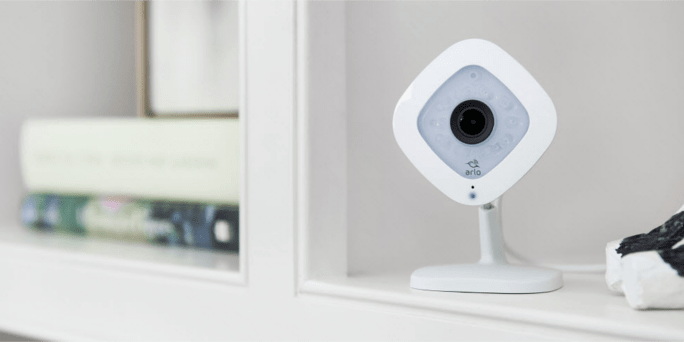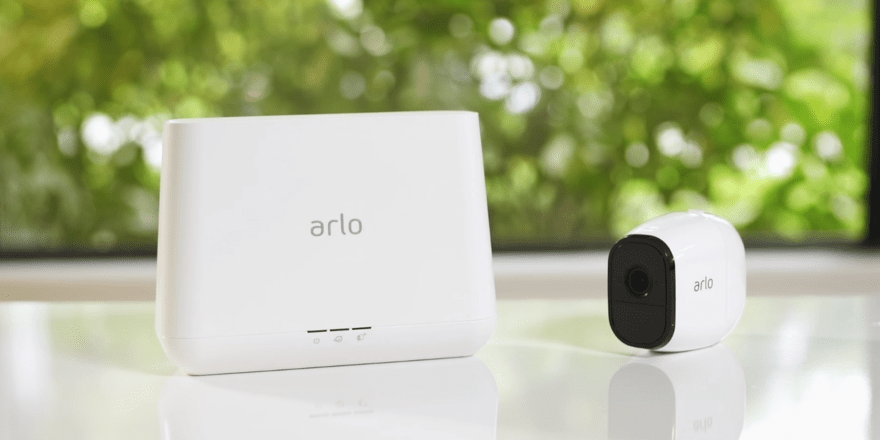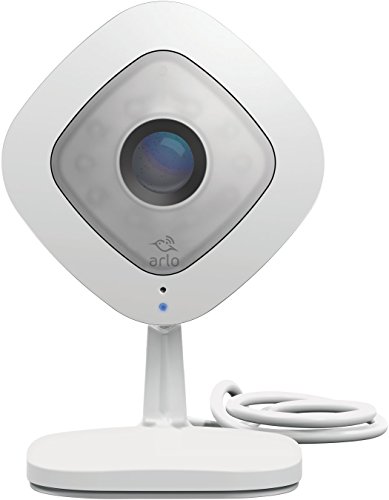Both cameras have quite a lot in common: they offer a 130-degree viewing angle and two-way audio so you can hear and be heard. And, you can enjoy rolling 7-day storage absolutely free of charge.
However, while there are a lot of similarities between the two cameras, there are a good amount of differences between the Arlo Q vs. Arlo Pro. So, let’s dive right into them to help you choose the right camera for your home.
Arlo Q vs. Arlo Pro — Differences
-
Difference #1: Power – Unlike the Arlo Q, the Arlo Pro features flexible powering options. You can use it wire-free and run it off of rechargeable batteries, or plug it in so you don’t have to worry about charging. If you do opt for battery power, consider taking advantage of the Arlo Solar Charger, available for Arlo Pro cameras.
The Arlo Q, on the other hand, is only capable of being powered via USB cable and power adapter. So in the event of a power outage, the Arlo Q is totally useless unless you plug it into a battery backup unit to work through short blackouts.
-
Difference #2: Base – Many smart cameras need additional equipment to function properly, and the Arlo Pro does require either an Arlo or Arlo Pro base. The Arlo Q works right out of the box, connecting to your home via your WiFi router. Just plug it in and sync with the Arlo app — it’s as simple as that!
-
Difference #3: Siren – A siren can be an important consideration for extra peace of mind, ensuring that you’ll always be alerted upon suspicious activity, while also acting as a theft deterrent. The Arlo Pro has a 100+ decibel siren through the base station that it connects to. The Arlo Q, though controllable through the Arlo app, doesn’t feature any siren functionality because it can’t connect to an Arlo base.
-
Difference #4: Video Quality – Video quality may also be a specification to keep in mind. After all, how useful is a smart camera if you can’t actually see what’s going on? The Arlo Q records in 1080p, while the Arlo Pro is only capable of a 720p resolution.
-
Difference #5: Local Storage – With local storage, you can rest assured that you’ll have access to all your recordings even in case of an internet outage. So, as far as there’s no power outage, all Arlo recordings will be saved locally.
This is perhaps the biggest difference when comparing the Arlo Pro vs. Arlo Q. With the Arlo Pro, all video recordings are stored to the cloud by default. You can, however, connect a USB device to the Arlo base station and use it as a second location to store Arlo Wire-Free and Arlo Pro Wire-Free recordings. The local storage is an additional feature, meaning you can’t disable the device’s cloud storage.
There are some cool ways in which the device interfaces with USB storage, like the Arlo app. It can notify you if the device is low on storage space or full. There’s also an option for automatic overwrite, meaning that the oldest recorded footage will be overwritten when storage space is filled up. Rest assured that the device won’t touch any other files on your USB storage — just the Arlo recordings.
The Arlo Q has no local storage. Although all of your cameras will appear on the Arlo app, only those actually synced to your Arlo base will have local USB recordings. The Q camera interfaces with your WiFi rather than the base, so it doesn’t support USB storage.
If you really want local storage on the Arlo Q, we recommend checking out the Arlo Q Plus. The Q Plus has everything the Q offers plus local storage via an SD card and flexible power options (PoE, Ethernet, Wi-Fi). Check out our take on Arlo Q vs. Arlo Q Plus — Differences Actually Explained for more info.
-
Difference #6: Motion Sensors – Many smart cameras trigger recording based off of sensors, and these two models vary in the way in which they handle motion sensing.
The Arlo Pro has adjustable sensitivity, with automatic email alerts and push notifications upon detection of activity. It uses a wide-angle PIR motion sensor that makes sure no movement will slip through without notice. However, as it’s using PIR technology, it’s not capable of detecting motion through windows, as the glass filters out IR.
The Arlo Q has adjustable sensitivity with a range of up to 50 feet. Enjoy instant email alerts and push notifications for instant feedback when motion is detected. The camera has support for three activity zones, focusing your motion detection on the areas that are most important to you for motion triggers that start automatic recording.
The Arlo Q camera uses pixel-based detection like many other smart cameras. This form of detection has a lot of advantages when compared to traditional infrared detectors, as it’s triggered by changes in what it sees and will work through windows.
-
Difference #7: Continuous Video Recording – Although motion-based detection is superior in most situations, some people may be interested in the option for continuous video recording.
Unfortunately, there aren’t a ton of options for continuous video recording on the Arlo Pro. Actually, the only way to use continuous recording is to manually start a recording — and even that will shut off after only 30 minutes.
Unlike the Arlo Pro, the Arlo Q offers an option for 24/7 recording, but you’ll have to get a CVR subscription for it. A la carte 24/7 cloud video recording will cost you $9.99 per month per camera for rolling 14 days or $19.99 per month per camera for rolling 30 days.
-
Difference #8: Usage – The Arlo Pro is perfect for outside use, with weather resistance and functionality at a temperature range of -4° to 113° F (-20° C to 45° C). The Arlo Q camera is only usable indoors.
-
Difference #9: Accessories – If you’re looking to customize your system with additional equipment, the Arlo Pro is the camera to go with, as the Arlo Q camera doesn’t really have much to offer when it comes to accessories.
The Arlo Pro offers skins to change the physical appearance of your camera, ensuring it blends in seamlessly with your home.
As mentioned above, one of the power options is a rechargeable battery that can be recharged in a variety of ways. The Arlo Charging Station allows you to charge up to two Arlo Pro batteries at the same time using quick charging technology, ensuring minimal surveillance downtime.
A unique and convenient option is the Arlo Solar Panel, which lets you automatically charge your battery in a more “hands-off” approach. Alternatively, you can use an Outdoor Power Adapter to keep your devices charged and connected 24/7.
The Arlo Pro also supports several different mounting options such as Quadpod, security, table and ceiling, and outdoor mounts.
Arlo Q vs. Arlo Pro — Comparison Chart
| Arlo Q | Arlo Pro | |
|---|---|---|
| Video resolution | 1080p HD | 1280 x 720p |
| Frames per Second | 30 FPS | 30 FPS |
| Video Format | H.264 | H.264 |
| On-Demand Live View | Yes | Yes |
| Record Live View | Yes | Yes |
| Field of View | 130° | 110° |
| Zoom | 8x digital zoom | 8x digital zoom |
| Power | AC | Rechargeable Battery/AC |
| Optional Power Source | No | Solar Panel |
| Battery Life | N/A | Battery: 3-6 months Solar: indefinitely |
| Two-Way Audio | Yes | Yes |
| Motion Detection | Up to 50 feet | Up to 23 feet |
| Built-in Motion Zones | Up to 3 activity zones | No |
| Person Detection | With Subscription | With Subscription |
| Facial Recognition | No | No |
| Sound Detection | Yes | Yes |
| Night Vision | 850 nm LEDs: illuminates up to 25 feet IR cut-off filter |
850 nm LEDs: illuminates up to 25 feet IR cut-off filter |
| Internet Connection | WiFi: 2.4 & 5GHz | WiFi: 2.4GHz |
| Requires a Base Station | No | Yes |
| Max # of Cameras per Base Station | – | 15 |
| Siren | No | Via the Base |
| 24/7 Recording | Optional | No |
| Local Backup Storage | No | Via the Base |
| Cloud Storage | 7-Day Free / Subscription | 7-Day Free / Subscription |
| Review, Share, & Save | Yes | Yes |
| e911 Emergency Call | With Subscription | With Subscription |
| Instant App Alerts | Yes | Yes |
| App Support | Android, iOS, FireOS, Web | Android, iOS, FireOS, Web |
| Rich Notifications | With Subscription | With Subscription |
| Weather-resistant | No | IP65 rating |
| LED Lights | No | Sold Separately Arlo Security Light |
| Amazon Alexa | Echo Show, Echo Spot | Echo Show, Echo Spot |
| Google Assistant | Yes | Yes |
| IFTTT | Yes | Yes |
| Stringify | Yes | Yes |
| Operating Temperature | Indoors | -4° to 113° F |
| Dimension | 2.75 x 2.80 x 4.50 in | 3.1 x 1.9 x 2.8 in |
| Color | White | White |
Arlo Q vs. Arlo Pro — FAQs

Can Arlo Pro work without Internet?
As long as there’s power, Arlo Pro cameras will continue working. However, they’ll use local USB storage instead of cloud storage, so make sure you have a USB in place on the back of the Arlo base. Also, keep in mind that local storage is not as easy to access as cloud storage.
How many Arlo Pro cameras per base can I use?
You can use up to 20 cameras per one base station with the Arlo Smart Elite plan. And in case you need to add more cameras, just add another base station. There’s no limit on the number of base stations that one can use.
Most definitely yes. This is one of the best parts about the Arlo Wire-free cameras, they’re all backwards compatible with the Arlo and Arlo Pro base stations. So you can add new cameras like the Arlo Pro 2 to your existing Arlo setup no problem.
Does Arlo Pro record audio?
Unlike it’s younger sibling, the original Arlo, the Arlo Pro comes with two-way audio. So the cameras have no problem recording videos with sound. Plus, you can set audio-triggered recordings.
Does Arlo Pro work with Wink?
Yes, so if you already have a smart home ecosystem focused around the Wink hub, you can integrate your Arlo Pro cameras. Once you connect the Arlo Pro to Wink, you can receive motion alerts for your Arlo Pro cameras in the Wink App, plus set up a Robot (certain action triggered by other action) to activate when the cameras detect motion or sound.
Arlo Q vs. Arlo Pro — Our Thoughts

The Arlo Pro and Arlo Q are from the same manufacturer, but there are a decent amount of differences. There are a number of ways in which these models excel, and there are certainly also some drawbacks. Which camera is right for you is going to be an individual decision, and there’s truly no “best overall” option. Depending on your needs, either of these two smart cameras will suit you well and add the peace of mind of reliable video surveillance of your home or business.
With that said, if you’re looking for an indoor camera with 1080p video resolution, support for CVR, and simple setup, the Arlo Q is your best bet.
And if you’re looking for a camera with more flexible options like indoor/outdoor use, wire-free/plug-in, then Arlo Pro is a better choice. Plus, with the Arlo Pro camera, you’ll get siren and support for local storage, which is quite a big benefit.
Last update on 2024-04-16 at 09:24 / Affiliate links / Images from Amazon Product Advertising API





